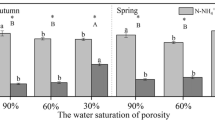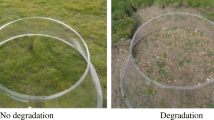Abstract
Aims
Dominant plant species may coexist and maintain high productivity in alpine wetland through available nitrogen (N) niche differentiation over time and space. We tested the hypotheses that dominant plant species differ in uptake of inorganic and organic N and that such differences depend on soil depth and season.
Methods
We conducted a short-term 15N-labeling experiment in an alpine wetland on the Tibetan Plateau. The experiment used a factorial design with three N forms (nitrate, ammonium and glycine), three soil depths (0–5, 5–10 and 10–15 cm), two seasons (May and July) and three dominant species (Carex muliensis, C. lasiocarpa and Potentilla anserina).
Results
All three species took up organic N (glycine), but showed different patterns over seasons and depths. 15N uptake rate was higher in May than in July in C. muliensis and C. lasiocarpa, but lower in May than in July in P. anserina. C. muliensis took up more 15NH4 + and 15NO3 − than glycine-15N at all soil depths. C. lasiocarpa took up more glycine-15N than 15NH4 + or 15NO3 at 5–10 cm depth. P. anserina showed little difference in uptake at any soil depths.
Conclusions
Dominant species in alpine wetland are able to take up both organic and inorganic N, but show different patterns depending on N form, soil depth, season and their interactions.



Similar content being viewed by others
References
Andresen LC, Jonasson S, Strom L, Michelsen A (2008) Uptake of pulse injected nitrogen by soil microbes and mycorrhizal and non-mycorrhizal plants in a species-diverse subarctic heath ecosystem. Plant Soil 313:283–295
Ashton IW, Miller AE, Bowman WD, Suding KN (2010) Niche complementarity due to plasticity in resource use: plant partitioning of chemical N forms. Ecology 91:3252–3260
Baptist F, Tcherkez G, Aubert S, Pontailler JY, Choler P, Nogues S (2009) 13C and 15N allocations of two alpine species from early and late snowmelt locations reflect their different growth strategies. J Exp Bot 60:2725–2735
Bardgett RD, Streeter TC, Bol DR (2003) Soil microbes compete effectively with plants for organic-nitrogen inputs to temperate grasslands. Ecology 84:1277–1287
Buckeridge KM, Jefferies RL (2007) Vegetation loss alters soil nitrogen dynamics in an Arctic salt marsh. J Ecol 95:283–293
Ding WX, Cai ZC, Wang DX (2004) Preliminary budget of methane emissions from natural wetlands in China. Atmos Environ 38:751–759
Gao J, Ouyang H, Xu X, Zhou C, Zhang F (2009) Effects of temperature and water saturation on CO2 production and nitrogen mineralization in alpine wetland soils. Pedosphere 19:71–77
Gioseffi E, de Neergaard A, Schjoerring JK (2012) Interactions between uptake of amino acids and inorganic nitrogen in wheat plants. Biogeosciences 9:1509–1518
Hargreaves SK, Horrigan EJ, Jefferies RL (2009) Seasonal partitioning of resource use and constraints on the growth of soil microbes and a forage grass in a grazed Arctic salt-marsh. Plant Soil 322:279–291
Henry HAL, Jefferies RL (2002) Free amino acid, ammonium and nitrate concentrations in soil solutions of a grazed coastal marsh in relation to plant growth. Plant, Cell Environ 25:665–675
Henry HAL, Jefferies RL (2003) Plant amino acid uptake, soluble N turnover and microbial N capture in soils of a grazed Arctic salt marsh. J Ecol 91:627–636
Jaeger CH, Monson RK, Fisk MC, Schmidt SK (1999) Seasonal partitioning of nitrogen by plants and soil microorganisms in an alpine ecosystem. Ecology 80:1883–1991
Johnsson L, Berggren D, Kårén O (1999) Content and bioavailability of organic forms of nitrogen in the O horizon of a podzol. Eur J Soil Sci 50:591–600
Jones D, Kielland K (2002) Soil amino acid turnover dominates the nitrogen flux in permafrost-dominated taiga forest soils. Soil Biol Biochem 34:209–219
Jones DL, Healey JR, Willett VB, Farrar JF, Hodge A (2005) Dissolved organic nitrogen uptake by plants—an important N uptake pathway? Soil Biol Biochem 37:413–423
Kuzyakov Y, Xu X (2013) Competition between roots and microorganisms for nitrogen: mechanisms and ecological relevance. New Phytol 198:656–669
Lebauer DS, Treseder KK (2008) Nitrogen limitation of net primary production in terrestrial ecosystems is globally distributed. Ecology 89:371–379
Lovett-Doust L (1981) Population dynamics and local specialization in a clonal perennial (Ranunculus repens): I. The dynamics of ramets in contrasting habitats. J Ecol 69:743–755
McKane R, Johnson L, Shaver G, Nadelhoffer K, Rastetter E, Fry B, Giblin A, Kielland K, Kwiatkowski B, Laundre J, Murray G (2002) Resource-based niches provide a basis for plant species diversity and dominance in arctic tundra. Nature 415:68–71
Miller AE, Bowman WD (2003) Alpine plants show species-level differences in the uptake of organic and inorganic nitrogen. Plant Soil 250:283–292
Miller AE, Schimel JP, Sickman JO, Skeen K, Meixner T, Melack JM (2009) Seasonal variation in nitrogen uptake and turnover in two high-elevation soils: mineralization responses are site-dependent. Biogeochemistry 93:253–270
Nasholm T, Kielland K, Ganeteg U (2009) Uptake of organic nitrogen by plants. New Phytol 182:31–48
Neff JC, Chapin FS, Vitousek PM (2003) Breaks in the cycle: dissolved organic nitrogen in terrestrial ecosystems. Front Ecol Environ 1:205–211
Song M, Xu X, Hu Q, Tian Y, Ouyang H, Zhou C (2007) Interactions of plant species mediated plant competition for inorganic nitrogen with soil microorganisms in an alpine meadow. Plant Soil 297:127–137
Sun Z, Liu J, Yu J, Qin S (2008) Effects of simulated wetland water change on the decomposition and nitrogen dynamics of Calamagrostis angustifolia litter. Environ Sci 29:2081–2093
Tian YB, Xiong MZ, Song GY (2005) Restoration succession of wetland soils and their changes of water and nutrient in Zoige Plateau. Chin J Ecol 24:21–25
Vitousek PM, Howarth RW (1991) Nitrogen limitation on land and sea: how can it occur? Biogeochemistry 5:7–34
Xu X, Ouyang H, Kuzyakov Y, Richter A, Wanek W (2006) Significance of organic nitrogen acquisition for dominant plant species in an alpine meadow on the Tibet plateau, China. Plant Soil 285:221–231
Xu Z, Ward S, Chen C, Blumfield T, Prasolova N, Liu J (2008) Soil carbon and nutrient pools, microbial properties and gross nitrogen transformations in adjacent natural forest and hoop pine plantations of subtropical Australia. J Soils Sediments 8:99–105
Xu X, Ouyang H, Cao G, Richter A, Wanek W, Kuzyakov Y (2011a) Dominant plant species shift their nitrogen uptake patterns in response to nutrient enrichment caused by a fungal fairy in an alpine meadow. Plant Soil 341:495–504
Xu X, Ouyang H, Richter A, Wanek W, Cao G, Kuzyakov Y (2011b) Spatio-temporal variations determine plant-microbe competition for inorganic nitrogen in an alpine meadow. J Ecol 99:563–571
Yu Z, Zhang Q, Kraus TEC, Dahlgren RA, Anastasio C, Zasoski RJ (2002) Contribution of amino compounds to dissolved organic nitrogen in forest soils. Biogeochemistry 61:173–198
Yu F, Li P, Li S, He W (2010) Kobresia tibetica tussocks facilitate plant species inside them and increase diversity and reproduction. Basic Appl Ecol 11:743–751
Zhu WX, Carreiro MA (2004) Temporal and spatial variations in nitrogen transformations in deciduous forest ecosystems along an urban–rural gradient. Soil Biol Biochem 36:267–278
Acknowledgments
We thank Prof. Peter Alpert for his English improvement. We also thank the anonymous reviewers for constructive comments on the manuscript. This research is supported by the Fundamental Research Funds for the Central Universities (TD-JC-2013-1) and the National Natural Science Foundation of China (41071329 and 30870424).
Author information
Authors and Affiliations
Corresponding author
Additional information
Responsible Editor: Ad C. Borstlap.
Rights and permissions
About this article
Cite this article
Gao, JQ., Mo, Y., Xu, XL. et al. Spatiotemporal variations affect uptake of inorganic and organic nitrogen by dominant plant species in an alpine wetland. Plant Soil 381, 271–278 (2014). https://doi.org/10.1007/s11104-014-2130-9
Received:
Accepted:
Published:
Issue Date:
DOI: https://doi.org/10.1007/s11104-014-2130-9




